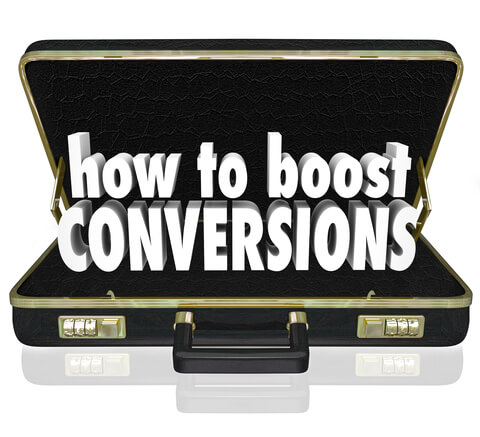In the world of sales and marketing, conversion means having a prospective customer take a specific action. Increasing your conversion rates is critical to sales success and, ultimately, your bottom line.
Here are some tips for improving conversion rates on your business website.
Establish your conversion point
Before you can begin efforts to increase conversion, you must be clear on what you consider a conversion. What metric or data point are you measuring? Note that this should align with your overall marketing strategy to be most successful.
Are you measuring purchases and final sales? Or are you simply hoping to get an email address from a new website visitor? Maybe you want prospects to sign up for your newsletter or download a whitepaper. Whatever you decide the action item to be, that is what you should measure and what you will eventually optimize. Make note of your starting point.
Remember that you can’t improve something you cannot measure. Take note of your current metrics and then track rates on a daily and monthly basis. Looking at daily statistics allows you to immediately see if you are having a problem. For example, if numbers suddenly drop, maybe a form is not working or a page is delivering an error message. Over a number of weeks, you should be able to see your progress and recognize trends.
The basics your website needs
It’s important that you have at least some (if not all) of these basic elements on your website:
- Sign-up form.
- Optimized landing pages.
- Call-to-action button or buttons.
- Updated content.
- A product page.
- Check-out page (for e-commerce).
Test your content
In order to determine which tactics work better than others, you need to perform split or A/B testing. (A/B testing is one of the most effective forms of improving website conversion rates.)
Companies that consistently measure their conversion points are twice as likely to have increased sales, but 61% of companies perform less than five conversion tests a month.
Use testing software to deliver one page to half of your audience and a different page to the other half. See how differently they perform. There are many elements you can test. Consider trying out different:
- Page layouts and navigation.
- Headlines.
- Landing pages.
- Web pages with a call to action.
- Call to action wording.
- Sizes of the button for the call to action.
Other improvements that see higher ROIs include shortening forms and writing clearer CTAs.
Create strong CTAs
Having a call to action (CTA) is imperative in conversion. Whatever you create, make sure your visitors can see it right away. Do this by keeping it above the fold or scroll.
This doesn’t mean you have to delete any CTA that is lower on the page. It just means that you must have one above it. Remember, it’s not a bad thing to have more than one CTA on a page. Just be sure you don’t confuse the visitor. Make the CTA the same action and purpose if there is more than one per page.
A/B test your call to action. If it isn’t already big, make it bigger. Consider Fitts’s Law: The closer and larger a target, the faster it is to click on that target. Digital marketing expert Neil Patel says, “Many companies I’ve worked with have simply made their call to action button a bit bigger, and watched their conversion rates grow by 10 percent to 25 percent.”
Offers
If your CTA is an offer, take a close look at what you are offering. Then research what your competition is offering. Is it the same thing? Are you offering a free trial or free consultation just as they are? To increase your conversion, offer something different and more compelling. Focus on solving the problem for your target audience. Then, create something that makes them want to take you up on your offer because you have the solution.
Forms
If your CTA includes a form, make it shorter. Most forms are too long. They include too much information or require too many fields to be filled in. Is your conversion to acquire email addresses? Then don’t create a form that asks for names, addresses or other information. Just get the email address. Focus on your conversion goal and delete other fields that will distract the visitor or make the process too cumbersome to complete.
Don’t be afraid to have multiple forms on multiple sites either. The more landing pages that your company has, the larger pool of leads you’ll have.
Design
To keep your visitor focused, make your web page designs as simple as possible. Make sure your navigation is trimmed down and easy to use. Users want to find things within two seconds of landing on a page. Review your pages to see if, in fact, the item you want a visitor to see is within a two-second scan.
Additionally, don’t waste space with clutter. Most people recognize that businesses will have social media accounts, so remove your social media feeds. They will happily click an icon if one is included on the page. Don’t attract attention away from your focal point by putting ever-changing feeds on the page. Many people are like goldfish that dart to the shiny thing that’s flashing instead of going directly toward the goal you set.
Make your “contact us” easy to find. Remember, 96% of visitors who come to your website are ready to buy, but they may not if it’s too hard to get in touch with you. You want to convert them by being there for them. Make it easy for them to connect with you.
If you create a form, include only the essential requirements for you to answer appropriately. Most businesses can get away with three fields: name, email address and reason for inquiry.
Ensure your site loads quickly. Even a one-second delay can result in a 7% reduction in your potential conversions.
Finally, make sure that your website includes media and video. Simple product videos can increase product purchases by 144% and increase your on-site visitors.
Testimonials
Potential customers may not know much about you when they first visit your website. Help them by providing information, not simply from your content, but from actual customers. This shows visitors that there are others in the target audience who are just like them, and they are pleased with what you are offering.
These testimonials create trust, and prospects will convert when they can trust you.
While you can offer a forum for feedback, providing a testimonial page that includes names and images of real people makes the page more authentic. If possible, consider creating very short video testimonials.
Need help?
If you have a content marketing program or are planning one, download our e-book 100 Mistakes Businesses Make When Starting, Optimizing and Scaling Content Marketing Programs.This e-book will walk you through the mistakes of hundreds of other companies and the challenges they faced in implementing their content marketing programs. To learn more about how Tempesta Media can help you streamline your content creation process and deliver quality content at scale, contact us today.












